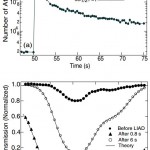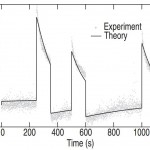Physical Review Letters, 2006: Low-Light-Level Optical Interactions with Rubidium Vapor in a Photonic Band-Gap Fiber
Citation: Ghosh S, Bhagwat AR, Renshaw CK, Goh S, Gaeta AL, Kirby BJ. Low-Light-Level Optical Interactions with Rubidium Vapor in a Photonic Band-Gap Fiber, Physical Review Letters, 97, 023603 (2006). doi pdf
Abstract: We show that rubidium vapor can be produced within the core of a photonic band-gap fiber yielding an
optical depth in excess of 2000. Our technique for producing the vapor is based on coating the inner walls
of the fiber core with organosilane and using light-induced atomic desorption to release Rb atoms into the
core. As an initial demonstration of the potential of this system for supporting ultralow-level nonlinear
optical interactions, we perform electromagnetically induced transparency with control-field powers in the
nanowatt regime, which represents more than a 1000-fold reduction from the power required for bulk,
focused geometries.
Figures:
- FIG. 1. A schematic of the experimental setup. Part of cell 1 is expanded to illustrate the region of the cell in front of the fiber tip. The beam reflected off a mirror at the back end of cell 1 is used to calibrate the density in the cell. PMT: photomultiplier tube.
- FIG. 2. (a) Measurement of the number of Rb atoms in the core of the photonic band-gap fiber as a function of time, obtained from a theoretical fit to the transition shown in the inset. (b) Variation of the absorption line shapes at three different times. The corresponding theoretically predicted absorption profile is shown by the solid line.
- FIG. 3. Measurement of the number of Rb atoms in the core of the photonic band-gap fiber (dots) as a function of time in the presence of a 60 microwatts desorbing beam at 770 nm, with the theoretical fit (line) from Eq. (2) to the experiment.
- FIG. 4 (color online). (a) Transmission spectra of the probe field in the presence of a 361-nW control field. The arrow shows the transparency window due to EIT. (b) Experimental and theoretical variation of the EIT linewidth as a function of control intensity.





